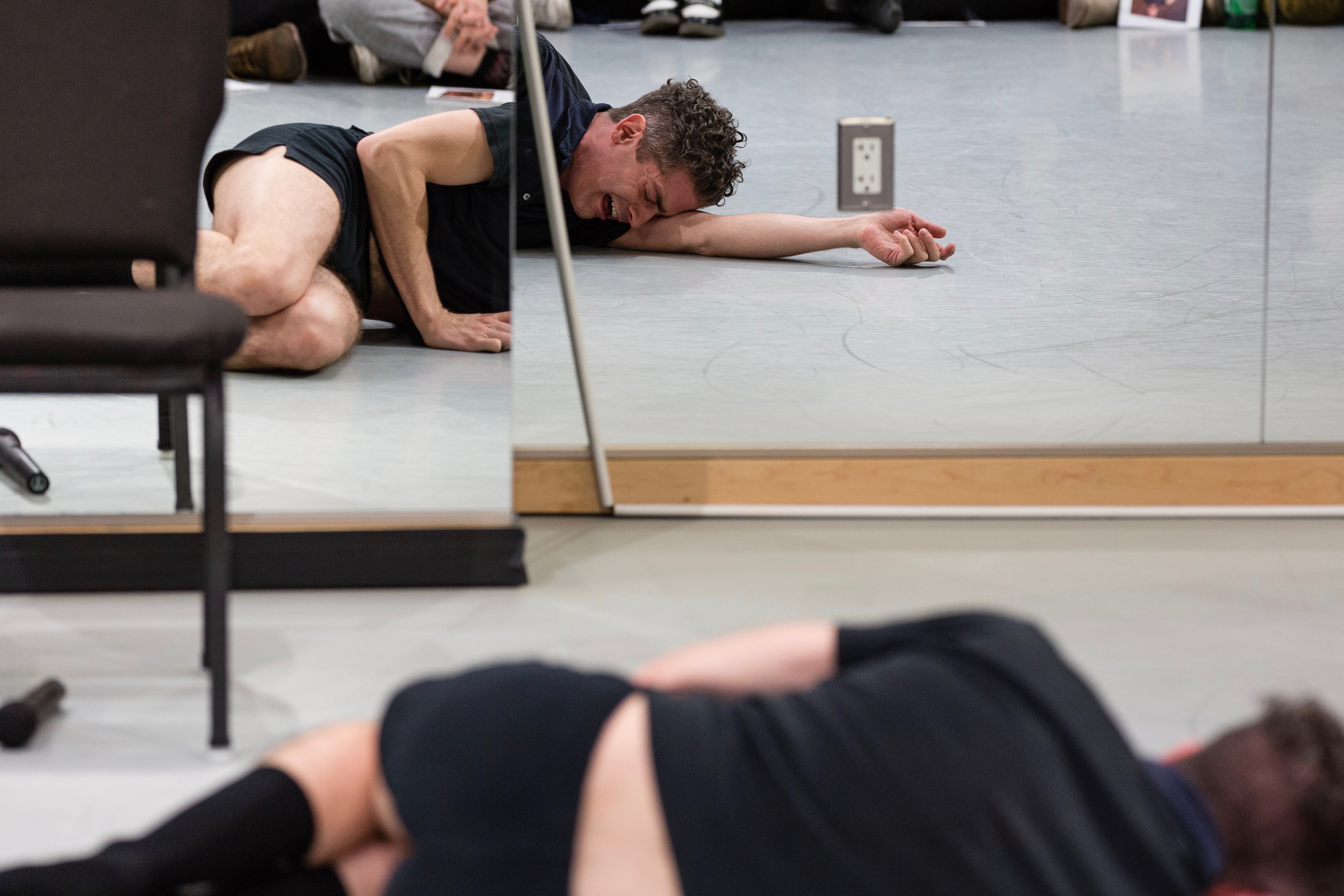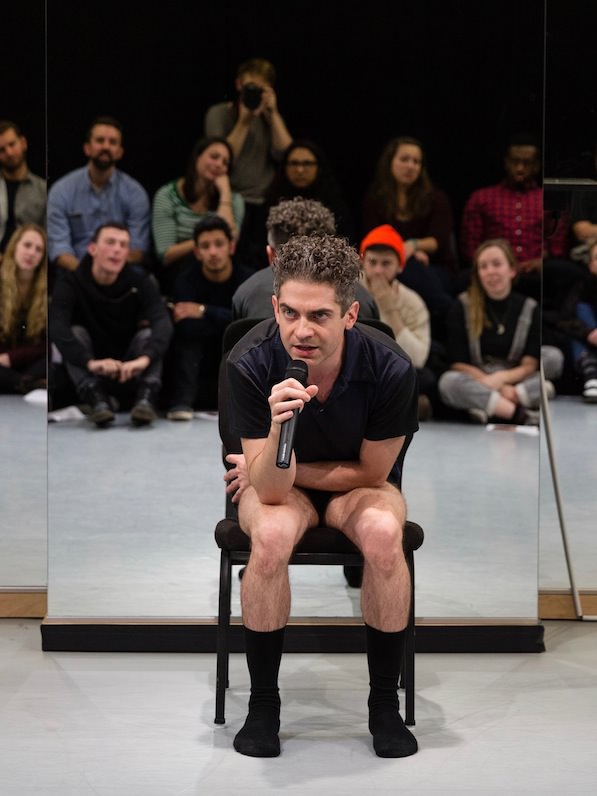
Jack Ferver & persona
Phillip Adams BalletLab was one of eight Victorian companies defunded by the Australia Council in last year’s Black Friday cuts. Undeterred, the company pushed ahead with its plan to establish new headquarters and a new performance venue at Temperance Hall in South Melbourne. It’s inspiring stuff: BalletLab continues to put itself out there with the help of a diverse range of supporters, unafraid of failure; but then that has been the ethos of this sui generis company from the beginning.
The storied venue on Napier Street was built by the Emerald Hill Total Abstinence Society in 1863, and over the years has hosted a range of notable performing arts companies, including Wal Cherry and George Whaley’s Emerald Hill Theatre Company and Jean-Pierre Mignon’s Anthill. You can still see something of the history of the building in the peeling palimpsest of paints on the walls and the ancient grime in the grain of the floorboards.
Reinvented as a presenting company, BalletLab aims to support what it calls queer-orientated practice and performance. What might this mean? Well, so far in 2017 the company has presented a remount of Chad McLachlan and Milo Hyde’s HardQueer DeathPony as part of Midsumma and recently announced Shian Law as artist-in-residence. Now they present their first international guest, New York-based writer, choreographer and director Jack Ferver.
Ferver’s Mon, Ma, Mes (Revisité) is a short but expertly crafted piece of satirical dance theatre which happily confuses or obscures relations between performer and character, confession and fictional monologue. The Jack Ferver we meet in the show is an alternative projection, a persona he can either claim or disown. The work is a fantasy and a confession and something a little bit sly and guileful.
It also hangs together rather beautifully, an achievement of tensions and themes and ambiguities. There is a long tradition of performers enacting characters with a shifting resemblance to autobiography, but Ferver does it with more panache than most.
The evening begins with a parody of an audience question-and-answer session in which Ferver plays the part of an ambitious young performance artist with seemingly limitless push. “Really,” he asks himself, “how old am I? I’ve made so much work, it’s like I’m a million years old.” From here we move into a series of confessional and pseudo-confessional fragments interspersed with short routines. Originality, or lack of it, is a recurring problem and an obsession for Ferver and his alter ego.
“We’re gonna do a thing where I’m gonna have him improvise and then I’m gonna say it’s mine,” he says, plucking a guest dancer from the audience. “It’s really in right now.”
The improvisation that ensues, with Luke George, is surprisingly effective, not only because George is a graceful mover, but because of Ferver’s studied intensity. He brings a similar focus and earnestness to his own solo dance routines, where he looks like a lost chorus dancer from a Golden-Age movie musical, briskly marching and lunging.
There is a feeling of where-have-I-seen-this-before familiarity that hangs over the performance. Occasionally this crystallises in a recognisable quote. “When I was 17,” he says, quoting the Gena Rowlands character in John Cassavetes’ Opening Night (1977), “I could do anything. It was so easy. My emotions were so close to the surface.” And yet even as he borrows from others, and exaggerates, there is a kind of submerged sincerity, which is never lost entirely.
It is this basic vulnerability that justifies the performance. At least, we assume it is basic, uncomplicated, unfeigned. Would this piece—which among other things tackles rape, suicide and failure—be tolerable otherwise, if it were inspired by cynicism?
At one point Ferver tells the audience that he cut his friend Reid from the show, ostensibly because that made it easier to tour. This gets a laugh because we recognise it as typical of the kind of ruthless narcissism that some artists feel is necessary in order to succeed. And yet it is true that Ferver’s friend Reid Bartelme has been cut from the show and—whatever the real reason—it is now easier to tour.
His monologue is wide-ranging and, as it goes on, increasingly disjointed. The shiny confidence we see at the beginning shatters almost immediately. Ferver interviews himself, playing both patient and therapist, ending with a comic-sexy-awkward dance. In another scene he cleverly uses a bank of mirrors at the back of the stage to create the impression that he is out for a walk, holding his own hand and chatting amiably with himself. It could be a symbol for the performance as a whole, reaching through the mirror and merging with his own reflection or, more accurately, creating the illusion that this is what he is doing.
In a brief pre-show speech, BalletLab artistic director Phillip Adams stressed the significance of New York as an inspiration and proving ground for so many Australian choreographers over the years. Indeed, New York was where Adams made a home in 1988, living and working there for 10 years.
Jack Ferver’s Mon, Ma, Mes (Revisité) also suggests a certain temperamental connection between Melbourne and the Big Apple. It is a piece in phase with the kind of darkly ironic performance that Melbourne-based performer Nicola Gunn has made her own, albeit with a camp twist, and somehow feels well suited to the city of folded arms.
–
BalletLab, Mon, Ma, Mes (Revisité), choreography, text Jack Ferver, performers Jack Ferver, selected guests; Temperance Hall, South Melbourne, 4 May
Top image credit: Mon, Ma, Mes (Revisité), Jack Ferver, photo Scott Shaw







